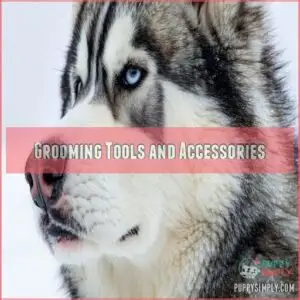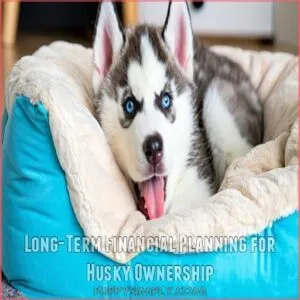This site is supported by our readers. We may earn a commission, at no cost to you, if you purchase through links.
 You’ll find that a husky’s price tag varies quite a bit, just like their stunning eye colors!
You’ll find that a husky’s price tag varies quite a bit, just like their stunning eye colors!
A companion husky pup typically costs between $600 and $2,000, while show-quality pups with champion bloodlines can fetch $2,500 to $5,000 or more.
If you’re budget-conscious, adoption from shelters runs $50 to $1,000.
But remember, the purchase price is just the beginning – you’ll need to factor in monthly expenses like premium food ($40-$100), vet care, grooming, and those inevitably destroyed snow boots.
Smart planning now will help you give your future furry snow queen the royal treatment she deserves.
Table Of Contents
- Key Takeaways
- Factors Influencing Husky Prices
- How Much Does a Husky Cost
- Initial Setup Costs for a New Husky
- Monthly Expenses of Owning a Husky
- Training and Socialization Expenses for Huskies
- Long-Term Financial Planning for Husky Ownership
- Potential Health Issues and Their Costs
- Tips for Owning a Husky on a Budget
- Frequently Asked Questions (FAQs)
- How much does it cost to adopt a husky?
- How much does a husky puppy cost?
- Are Siberian Huskies expensive?
- How much does a husky cost in the UK?
- Are Huskies worth the price?
- How much does Husky pet insurance cost?
- Why are huskies so expensive?
- Is a husky a good house dog?
- What is the price of a husky dog?
- How much does a Siberian Husky cost in the US?
- Conclusion
Key Takeaways
- You’ll pay $600-$2,000 for a companion husky, but show-quality pups cost $2,500-$5,000 or more.
- Adoption offers a cheaper alternative, costing $50-$1,000.
- Expect roughly $135 in monthly expenses for food, vet care, and grooming.
- Factor in $700-$1,500 for initial setup costs like a crate, bed, and vet visits.
Factors Influencing Husky Prices
You’ll find that several key factors can make a Husky’s price tag swing from $600 to over $5,000, including their bloodline, coat color, and where you’re buying from.
If you’re planning to bring home one of these blue-eyed beauties, you’ll want to understand how features like show-quality genetics and even your location can affect what you’ll pay at the end of the day.
Breed Popularity and Demand
Over the last few years, Huskies have skyrocketed in popularity, which directly impacts their price.
You’ll notice this surge in demand through:
- Growing waitlists at reputable breeders, often 6-12 months long
- Rising average prices, especially in urban areas
- Increased presence on social media and in pop culture, leading many to seek out products and supplies specifically for husky breeder needs, such as those found on Husky Breeder Supplies
This popularity boom means you’re looking at higher prices than just a few years ago, with market rates constantly adjusting to meet demand.
Bloodline and Pedigree
While breed demand drives prices, a Husky’s family tree can make your wallet considerably lighter.
Champion bloodlines typically command $2,500-$5,000+, compared to $600-$2,000 for companion pups.
You’re not just paying for papers – you’re investing in generations of health testing and proven genetics.
Think of it like buying a luxury car: prestigious lineage comes with higher performance standards and a steeper price tag.
Coat Color and Markings
Just like their pedigree, a Husky’s coat color and markings can greatly impact their price.
Red Huskies often fetch premium prices due to their rarity, while classic black and white patterns remain popular choices.
You’ll find various patterns including agouti, sable, and piebald, each affecting the price differently.
Some rare coat combinations, especially those with unique facial markings, can command higher prices from specialized breeders.
Eye Color Variations
Since eye color plays a fascinating role in Husky pricing, you’ll often see higher costs for pups with striking variations.
Those gorgeous blue eyes might grab attention, but don’t forget that a puppy’s eye color can change as they grow.
Bi-colored eyes (heterochromia) typically command premium prices, sometimes adding $200-$500 to the base cost, though this varies by breeder and region.
Breeder Reputation
Beyond eye colors, a breeder’s reputation plays a major role in what you’ll pay for a Husky.
Reputable breeders invest heavily in health testing, proper facilities, and post-sale support, which affects their pricing.
You’ll find that established breeders with proven track records, positive reviews, and transparent breeding practices often charge more.
However, their puppies typically come with health guarantees and lifetime support – making the investment worthwhile.
Geographic Location
Across the country, husky prices swing dramatically based on where you live. Your location plays a bigger role in the final price tag than you might think. Here’s what affects regional pricing:
- States with higher costs of living (like California and New York) typically see prices 30-40% above average
- Areas with more registered breeders tend to have competitive pricing
- Rural locations often have lower prices but higher transport fees
- Popular husky states like Texas and Florida maintain steady mid-range prices
How Much Does a Husky Cost
You’ll find that Siberian Husky prices vary widely in 2024, with companion puppies typically costing between $600 and $2,000 from reputable breeders.
If you’re interested in show-quality Huskies, you can expect to pay anywhere from $2,500 to over $5,000.
Adoption from shelters offers a more budget-friendly option at $50 to $1,000.
Companion Husky Puppies ($600-$2000)
Looking for a companion Husky puppy?
After checking every factor, you’ll find most family-friendly Huskies cost between $600 and $2,000.
This price range gets you a healthy pup from a reputable breeder, complete with basic health screenings and initial vaccinations.
Keep in mind that location plays a big role – you might pay more in urban areas where demand is higher.
Show Potential Huskies ($2500-$5000+)
When you’re diving into show potential Huskies, you’ll need deeper pockets than with companion pups.
These special breeds typically cost between $2,500 and $5,000, reflecting their superior genetics and show ring potential.
Additionally, their prices can also be influenced by factors such as breed popularity and demand, which can drive up costs, especially in urban areas.
Here’s what makes them stand out:
- Strong conformity to breed standards
- Premium pedigree lineage
- Early training for show environments
- Professional evaluation from breed experts
Keep in mind, this investment opens doors to show competitions – though success isn’t guaranteed.
Guaranteed Show Quality Huskies ($5000+)
Getting your hands on a guaranteed show quality Husky means you’re in the premium league, with prices starting at $5,000.
These top-tier pups come from champion bloodlines and meet strict breed standards for conformation.
You’re not just paying for looks – these Huskies come with extensive health guarantees, DNA testing, and championship-worthy genetics.
Remember, renowned breeders often have waiting lists for these exceptional specimens.
Retired Adult Huskies ($350-$1000)
Retired show and breeding Huskies offer a perfect blend of experience and value, typically priced between $350-$1000. These seasoned companions come with established personalities and often professional training under their belts.
- Most retired Huskies already know basic commands and house manners
- They usually have complete health records and documented lineage
- Their energy levels tend to be more moderate than puppies
- Many maintain their show-quality appearance and temperament
Adoption Costs ($50-$1000)
Looking to save money while giving a Husky a loving home? Adoption through shelters and rescues offers a budget-friendly option, with fees typically ranging from $50 to $1000.
These costs often include initial vet care, vaccinations, and spaying or neutering.
Your local humane society might’ve lower fees, while breed-specific rescues tend to charge more but offer specialized support and thorough health screenings.
Initial Setup Costs for a New Husky
You’ll need to budget between $700 and $1,500 for your new Husky’s essential starter kit, which includes everything from a cozy crate to those first vet visits.
Just like preparing a nursery for a baby, setting up your home for your furry friend means checking off important items like bowls, beds, grooming supplies, and puppy-proofing materials.
Essential Supplies (Crate, Bed, Bowls)
Your Husky’s comfort starts with essential supplies that’ll keep them happy and healthy.
You’ll need a sturdy crate ($50-$150), cozy bed ($30-$80), and durable stainless steel food and water bowls ($15-$30).
Don’t forget quality grooming tools ($40-$100) – those double coats need regular maintenance!
Add some basic toys ($20-$40) and a collar with leash ($25-$50), and you’re looking at around $200-$450 for initial supplies.
Medical Expenses (Spay/Neuter, Microchip, Vaccinations)
Initial medical expenses for a Husky puppy pack quite a punch.
You’ll need to budget around $200-400 for spaying/neutering, $45-55 for microchipping, and $75-100 for core vaccinations.
Don’t skip these essential investments – they’re vital for your pup’s health and can prevent costly issues down the road.
Many vets offer wellness packages that bundle these services, potentially saving you money.
Grooming Tools and Accessories
Three essential grooming tools will save your sanity when dealing with a Husky’s notorious double coat.
Start with a sturdy undercoat rake ($15-25), a slicker brush ($10-20), and a metal comb ($8-15) for those tricky spots.
Don’t forget bath-time basics: gentle shampoo ($12-18), conditioner ($10-15), and a high-velocity dryer ($80-150) to handle seasonal blow-outs like a pro.
Training Equipment and Classes
Getting a handle on training costs can feel like solving a puzzle.
A basic setup runs about $100-$200 for a sturdy harness, leash, and clicker.
Group classes typically range from $50-$150 per session, while private training might set you back $75-$100 per hour.
Online resources can help trim costs – many experienced husky trainers offer digital courses starting at $30.
Puppy-Proofing Your Home
Before your husky puppy bounds through the door, you’ll need to safeguard your home and wallet.
Plan on spending $150-300 for essential puppy-proofing supplies, which can be found at online retailers like puppy proof online stores.
This includes cord covers ($20-30), furniture corner guards ($25), baby gates ($40-80), and cabinet locks ($15-25).
Don’t forget to remove toxic plants and secure potential escape routes – these clever pups are known for their Houdini-like abilities!
Monthly Expenses of Owning a Husky
You’ll need to set aside around $135 each month to keep your husky happy and healthy, covering everything from premium food to regular vet checkups.
While this might seem like a lot at first, you’ll find it’s worth every penny when you see your furry friend thriving with proper care and attention.
Premium Food Costs ($40-$100)
Your hungry Husky’s food bowl needs quality fuel to keep up with their boundless energy.
Premium dog food typically costs between $40-$100 monthly, varying by brand and portion size. A 25lb bag of high-quality kibble averages $55.
- Raw food diets can double your monthly expenses, but many owners swear by the improved coat and energy levels
- Budget-friendly options like bulk buying can slash costs by 30%
- Homemade recipes, while time-consuming, often cost less than premium brands
Regular Veterinary Care
Regular vet care sets you back around $500-$1000 annually for routine checkups, vaccinations, and preventative treatments.
Monthly heartworm and flea medications typically cost $20-30, while annual vaccines run $100-200.
Pet insurance helps offset these expenses, usually ranging from $30-50 monthly.
Don’t skip dental cleanings – they’re pricey at $200-400 but prevent costly issues down the road.
Grooming Services or Supplies
Managing a Husky’s thick double coat is like tending to a small cloud factory.
Professional grooming sessions run $50-$100 monthly, but you can save by grooming at home.
A basic kit with brushes, combs, and nail clippers costs around $50-$75 upfront.
During shedding season, expect to spend more time (and find more fur) as your Husky "blows" their coat twice yearly.
Toys and Enrichment Activities
Since Huskies need constant mental stimulation, setting aside $10-15 monthly for toys and enrichment keeps them happy and out of trouble.
Here’s what experienced Husky owners typically invest in:
- Puzzle toys and treat-dispensing balls ($15-25 each)
- Durable chew toys like Kong Extremes ($12-20)
- Interactive feeders and snuffle mats ($20-30)
Mix these with DIY enrichment games using household items to keep costs down while keeping your pup engaged.
Pet Insurance Premiums
With a breed known for its adventurous spirit, pet insurance for your husky typically runs between $35-$75 monthly.
The exact premium depends on factors like your pup’s age, location, and coverage level.
Most providers offer plans covering accidents, illnesses, and routine care.
While it might seem like an extra expense, insurance can save you thousands if your husky needs unexpected medical care.
Training and Socialization Expenses for Huskies
You’ll need to set aside $100 to $1,000 for professional training programs to help your Husky master essential commands and social skills.
If you’re bringing home a Husky puppy, early investment in training classes will prevent costly behavioral issues later, as these smart but stubborn dogs need proper guidance from the start.
Professional Training Programs
Professional training programs for your Husky typically range from $50 to $150 per group session or $100 to $200 for private lessons.
These programs focus on essential commands, leash training, and socializing your energetic pup.
Top-rated local trainers often offer package deals around $500-$1000 for 6-8 weeks of classes.
Look for trainers who specifically understand the unique challenges of working with this independent breed.
Behavioral Consultations
Beyond standard training, behavioral consultations help tackle specific Husky quirks head-on, which is especially useful when dealing with their unique blend of independent thinking skills.
A one-on-one session with a certified behaviorist typically costs $100-200 per hour, addressing issues like:
- Excessive howling that’s driving your neighbors crazy
- Counter-surfing adventures in your kitchen
- Escape artist tendencies that would impress Houdini
- Furniture redecorating sessions (aka destructive chewing)
- That stubborn "selective hearing" when called
These targeted sessions often save money in the long run by preventing costly behavior-related problems.
Socialization Classes and Activities
Socialization classes open up a whole new world for your husky puppy.
After consulting with behavioral experts, you’ll want to explore group activities that build confidence and social skills.
Here’s what you can expect to spend on various socialization options:
| Activity Type | Cost Range | Benefits |
|---|---|---|
| Puppy Socials | $15-25/session | Controlled playtime |
| Dog Park Pass | $30-50/month | Daily interaction |
| Group Classes | $50-100/6 weeks | Structured learning |
| Husky Meetups | Free-$10 | Breed-specific play |
| Adventure Walks | $25-40/session | New environments |
Ongoing Obedience Reinforcement
Keeping up with your husky’s obedience training isn’t just a one-and-done deal – it’s an ongoing investment in their success.
You’ll want to budget around $50-100 monthly for refresher classes or training tools.
From reinforcing basic commands to tackling new challenges, consistent practice helps maintain your husky’s good behavior.
Many owners find that group training sessions offer great value, combining obedience work with socializing opportunities.
Long-Term Financial Planning for Husky Ownership
You’ll need to think beyond just the price tag of your new Husky pup, as these beautiful dogs can cost you around $135 monthly for basics like food, grooming, and routine vet care.
Just like planning for a family member, you’ll want to set aside money for both expected costs and those surprise vet visits that can pop up over your Husky’s lifetime.
Annual Cost Projections
Looking ahead at your yearly husky budget helps you plan smarter.
You’ll need about $1,620 annually for basic care, breaking down to $135 monthly.
This covers premium food ($480/year), regular insurance ($420/year), grooming supplies ($240/year), toys ($120/year), and routine vet visits ($360/year).
These numbers can vary based on your location and lifestyle choices, but they’re solid starting points for planning.
Emergency Fund for Unexpected Expenses
Every Husky owner needs a solid emergency fund – think of it as your furry friend’s safety net.
Most vets recommend setting aside at least $1,500-$3,000 for unexpected health issues.
While pet insurance helps cover many costs, you’ll still need cash for deductibles and non-covered expenses.
Start small by tucking away $50-100 monthly, and you’ll build a comfortable cushion for those surprise vet visits.
Budgeting for Aging Husky Care
As your Husky enters their golden years, planning ahead for their care becomes very important.
Set aside around $1,500-2,000 annually for senior-specific needs.
This budget should cover specialized joint supplements ($30-50 monthly), senior-formulated diet ($60-80 monthly), more frequent vet check-ups ($400-600 annually), and potential mobility aids like ramps or orthopedic beds ($100-300).
Remember, preventive care now saves money on bigger issues later.
Balancing Quality Care With Cost-Effectiveness
Many Husky owners find creative ways to balance quality care with their budget.
You can trim costs by learning DIY grooming techniques, preparing homemade treats, and shopping smart for supplies during sales.
Consider joining local Husky groups to share experiences and resources.
Pet insurance might seem like a splurge, but it often saves money long-term by covering unexpected vet bills.
Potential Health Issues and Their Costs
While your Husky might seem like the picture of health today, you’ll want to be prepared for potential health issues that could cost anywhere from $300 to $6,000 to treat.
Just like putting money aside for a rainy day, setting up a health fund or getting pet insurance can help you handle these surprise vet bills without breaking the bank.
Hip Dysplasia
Hip dysplasia in Huskies feels like a financial curveball that could cost you up to $6,000 in treatment.
This joint condition, where the hip socket doesn’t fit properly, often shows up in younger dogs but can develop later.
Regular vet checkups and genetic testing (around $200) help catch it early.
Pet insurance and preventive care, like maintaining a healthy weight, can soften the financial impact.
Uveodermatologic Syndrome
Your Husky’s health can face a serious challenge with uveodermatologic syndrome, a condition affecting both eyes and skin that typically costs between $2,000-$3,000 to treat.
This autoimmune disease requires prompt attention, and here’s what you should watch for:
- White patches appearing on your pup’s nose or around the eyes
- Sudden changes in eye color or cloudiness
- Noticeable skin depigmentation, especially on the face
Early detection and treatment are essential for managing this condition effectively.
Corneal Dystrophy
While managing uveodermatologic syndrome requires careful monitoring, corneal dystrophy presents another eye-related challenge for Husky owners.
This inherited condition causes cloudy deposits in the cornea, potentially affecting your pup’s vision, much like the eye conditions in Golden Retrievers that can lead to progressive retinal atrophy.
Treatment costs typically range from $1,500 to $3,000, depending on severity.
Early genetic testing ($150-200) can help identify risks, while regular eye exams ($75-100) are key for catching symptoms before they worsen.
Entropion
Entropion in Huskies can be a real pain – literally.
This condition makes their eyelids roll inward, causing their lashes to scratch their corneas.
It’s not just uncomfortable; it can cost you between $800 to $1,500 for corrective surgery.
Watch for signs like excessive tearing, squinting, or eye rubbing.
The good news? Early detection and treatment can prevent serious complications and keep your pup’s beautiful eyes healthy.
Follicular Dysplasia
Follicular dysplasia in Huskies can cost up to $500 for diagnosis and treatment.
This genetic condition affects your pup’s coat, causing patchy hair loss and changes in fur texture.
Early detection through genetic testing (around $150) can help manage symptoms before they worsen.
The good news? Most cases are mild and treatable with regular vet checkups and proper coat care routines.
Tips for Owning a Husky on a Budget
You don’t need a gold-plated collar to give your husky a happy life, and there are plenty of smart ways to cut costs without cutting corners on care.
With some creative planning and money-saving strategies, you’ll learn how to provide excellent care for your furry friend while keeping your wallet as cool as a husky’s natural habitat.
Saving Money on Husky Care
Smart Husky owners know that caring for these majestic dogs doesn’t have to break the bank.
With some savvy planning and creative solutions, you can provide excellent care while keeping costs manageable.
Here are some budget-friendly strategies that won’t compromise your pup’s wellbeing:
- Buy food in bulk during sales and store it properly to maximize savings
- Look for gently used supplies on marketplace apps or local pet groups
- Consider pet insurance early to avoid costly surprises later
Affordable Grooming Options
Looking to keep your husky’s coat gorgeous without breaking the bank?
You can find a suitable undercoat rake by checking out options available at undercoat rake stores.
DIY grooming can save you hundreds.
Start with a quality undercoat rake ($15-30) and slicker brush ($10-20) – they’ll handle most of your shedding battles.
Schedule baths every 6-8 weeks using pet-store brand shampoo ($8-15).
Many groomers offer package deals or loyalty discounts for regular visits, potentially saving 20-30% annually.
Cost-Effective Training Methods
You don’t need expensive trainers to develop a well-behaved husky.
Positive reinforcement and consistency work wonders for these intelligent pups, often at little to no cost.
- Join local husky meetup groups for free socialization and training tips
- Watch YouTube tutorials from certified trainers for DIY techniques
- Share training sessions with other husky owners to split costs
- Use household items as training tools and rewards
- Practice basic commands during daily walks
Budget-Friendly Food Choices
Finding budget-friendly food for your husky doesn’t mean compromising on quality.
Consider exploring affordable natural alternatives that offer a balance of nutrition and cost-effectiveness.
Mix premium kibble with homemade additions like lean chicken or turkey to stretch your dollar.
Buy in bulk when your go-to brands are on sale, and compare ingredients rather than just prices.
Some budget brands actually pack better nutrition than their expensive counterparts.
Just check the protein content stays above 25% for your husky’s high-energy needs.
Frequently Asked Questions (FAQs)
How much does it cost to adopt a husky?
Time is money when adopting a husky, with costs ranging from $50-$1000 at shelters and rescues. You’ll typically spend $200-$400, which includes initial vet care and basic supplies.
How much does a husky puppy cost?
Companion Siberian Husky puppies typically cost between $600 and $2,000, while show-quality pups can reach $5,000 or more. Your location, the breeder’s reputation, and the puppy’s lineage influence the final price.
Are Siberian Huskies expensive?
Siberian Huskies can be pricey, with initial costs ranging from $600 to $5000+ depending on quality. You’ll also need to budget for monthly expenses around $135 for food, grooming, and healthcare.
How much does a husky cost in the UK?
You’ll find a purebred husky puppy in the UK typically costs between £500-£1, Prices can vary based on lineage, registration status, and location, with show-quality dogs reaching upwards of £2,
Are Huskies worth the price?
Like a hidden gem in the dog world, these loyal companions are worth every penny.
Consider their intelligence, stunning looks, and loving nature – just make sure you’re ready for their exercise needs and grooming costs.
How much does Husky pet insurance cost?
Pet insurance for a Husky typically costs between $35-65 monthly, depending on coverage level and your location.
Most owners opt for mid-tier plans around $45/month that cover accidents, illnesses, and routine care.
Why are huskies so expensive?
Think of huskies like luxury cars – their price reflects quality breeding, health testing, and specialized care.
Their striking looks, high energy needs, and rising popularity also drive up costs for responsible breeders.
Is a husky a good house dog?
Huskies need lots of exercise and attention to thrive indoors.
While they can adapt to house living, you’ll need to provide daily runs, mental stimulation, and proper training to prevent destructive behaviors.
What is the price of a husky dog?
It won’t break the bank to bring home a husky pup. You’ll typically spend $600-$2,000 for a companion puppy, while show-quality huskies run $2,500-$5,000+. Rescue options start around $
How much does a Siberian Husky cost in the US?
You’ll typically spend between $600-$2,000 for a companion Siberian Husky puppy, while show-quality pups can cost $5,000+. Alternatively, you can adopt from shelters for $50-$1,000, saving money and helping rescues.
Conclusion
Like a snowflake, every husky journey is unique.
While initial costs for how much a husky runs between $600-$5000+, the real investment comes from providing quality care throughout their 12-15 year lifespan.
Factor in food, vet visits, grooming, and training – you’re looking at $1000-1500 annually.
But with proper planning and budgeting, you’ll create an amazing life with your husky companion.
Remember: their loyalty and love make every dollar worthwhile.






















